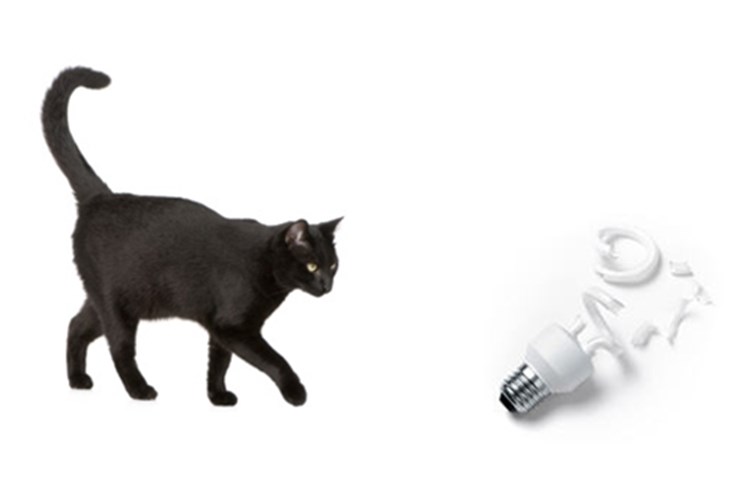While avoiding black cats may not be a particularly beneficial superstition today. Avoiding contamination by broken florescent light bulbs could very well prove to be a valid superstition that could protect your health, your family, friends and pets.
In the past a broken light bulb was of little consequence once the shattered glass was safely collected, contained and binned. Today compact florescent light bulbs are replacing iridescent light bulbs and the threat of contamination from breakage very real around the home and in the workplace. Intact fluorescents pose little threat to your health. Broken ones however do.
When a florescent bulb breaks mercury escapes as vapor that can be inhaled and as a fine powder that can settle into carpet and other textiles. At least one case of mercury poisoning has been linked to a box of fluorescents that broke in a children’s playground.
What should I do if a florescent bulb breaks?
For breakage on a hard surface:
1. Ventilate the room by closing all interior doors and vents, opening windows and any exterior doors in the room and leaving the room (restrict access) for at least 15 minutes.
2. Remove all materials you can and DO NOT VACUUM.
a. Wear disposable gloves, if available.
b. Carefully clean up the glass fragments and residue with a stiff paper or cardboard (such as playing cards or index cards).
c. Pick up any remaining small pieces of glass and residue using tweezers and sticky tape (such as masking or duct tape).
d. Wipe the area clean with a damp paper towel, cloth or disposable wet wipe.
3. Place all cleanup materials (cardboard, gloves, tape, etc.) in a sturdy glass container with a tight fitting metal lid such as a canning jar or peanut butter jar.
Store the container outside of the house in an area inaccessible to children until you are able to dispose of it at a household hazardous waste location.
4. Wash your hands.
5. Leave windows in the affected room open as long as practical (weather permitting).
For breakage on carpet: Complete steps 1 through 5 above then:
6. If rug is removable, take it outside, shake, and air out as long as practical.
7. After the cleanup, the first time you vacuum the area where the CFL was broken, shut the door to the room or close off the area from as much of the rest of the house as possible and ventilate the room when vacuuming.
Remove the vacuum bag when done cleaning the area, wipe vacuum with wet wipe and put the bag and/or vacuum debris,
including cleaning materials, into a plastic bag and double bag and store the bag outside the house in an area inaccessible to children as in #3 above.
8. After vacuuming, keep windows open, door closed and children/pets out of room for 1-2 hours.
9. Consider removal of carpeting where the breakage occurred as a precaution if there are infants, small children and/or pregnant women who will be using the room.
What are the health effects from mercury?
Almost all people have trace amounts of mercury in their tissues. Factors that determine how severe the health effects are from mercury exposure include:
· Form of mercury (such as methylmercury from eating fish or elemental mercury from broken fluorescent light bulbs).
· Dose (how much a person is exposed to).
· Health and age of the person (the fetus is the most susceptible).
· Route of exposure (inhalation, ingestion, skin contact).
Liquid elemental mercury primarily causes health effects when it is inhaled as a vapour. These exposures can occur when elemental mercury is spilled or products that contain mercury break and release vapours into the air - this is especially a problem in warm or poorly-ventilated indoor spaces. Symptoms of inhaling mercury vapours can include nausea, respiratory problems, tremors, numbness in the fingers and toes, loss of muscle control, memory loss, kidney disease, and heart problems. Some of these effects can be reversible if the exposure stops, however, memory problems can be permanent.
How do I dispose of items containing mercury?
To keep mercury out of the fish we eat and the air we breathe, it's important to take mercury-containing products to a hazardous waste facility for disposal. All mercury-containing products, such as old mercury thermometers, thermostats, fluorescent lights, and containers of elemental mercury are considered hazardous and must be properly disposed of at a hazardous waste facility. Broken fluorescent bulbs, mercury thermometers, and the materials used to clean up the spill should also be taken to a hazardous waste facility and excluded from general waste.
